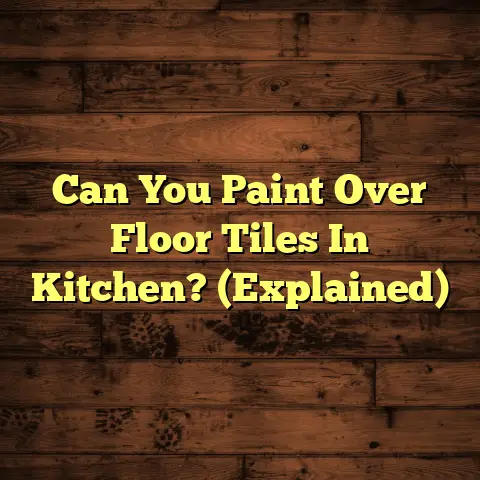Fix Squeaky Carpeted Floors ASAP! (2 Methods)
And let me tell you, there’s one thing that drives me (and my clients!) absolutely bonkers: squeaky floors.
But not just any squeaky floors, those sneaky squeaks hiding under the carpet.
It’s like living in a haunted house, except the ghost is just your subfloor screaming for attention.
But hey, in recent years, I’ve noticed a fantastic shift. More and more homeowners are thinking green.
They want to fix their homes, but they want to do it in a way that’s good for the planet too.
That’s why I’m so excited to share these two methods for silencing those carpeted floor squeaks.
They’re effective, affordable, and, most importantly, they’re eco-friendly.
Let’s dive in and get those floors quiet!
Understanding Squeaky Floors
Okay, so why do floors squeak in the first place? Especially under that nice, soft carpet?
Well, it’s usually one of a few culprits. Think of your floor like a layered cake.
You’ve got the subfloor (usually plywood or OSB), then maybe some padding, and finally, the carpet.
Common Causes:
-
Loose Floorboards: This is the big one. Over time, the nails or screws holding the subfloor to the joists (those wooden beams underneath) can loosen.
This creates movement, and when those surfaces rub together, you get that annoying squeak.
Think of it like this: imagine two pieces of wood trying to rub together, that friction creates noise. * Improper Installation: Sometimes, it’s just a bad install. Maybe the subfloor wasn’t properly secured from the get-go.
Or perhaps the carpet wasn’t stretched tightly enough, allowing movement underneath.
I’ve seen it all, trust me. * Temperature and Humidity: Wood expands and contracts with changes in temperature and humidity.
This can cause the subfloor to shift and create gaps, leading to squeaks.
Ever notice your floors are squeakier in the winter? That’s probably why! * Materials in Traditional Carpet Installation: Traditional carpet installation involves materials like tack strips, which can become loose over time, and adhesives, which can degrade.
The carpet padding itself can also compress and lose its cushioning ability, leading to more direct contact between the carpet and the subfloor.
This direct contact increases the likelihood of squeaks as the carpet rubs against the subfloor with every step.
Eco-Conscious Flooring Choices:
Now, here’s something to consider before you even get to the squeaking stage: eco-friendly flooring choices.
If you’re planning a new carpet install, think about sustainable materials like:
- Recycled Carpet: Made from recycled plastic bottles or other materials.
- Natural Fiber Carpet: Wool, sisal, jute, and other natural fibers are renewable and biodegradable.
- Eco-Friendly Padding: Look for padding made from recycled materials or natural rubber.
Not only are these options better for the environment, but they can also be quieter and more durable in the long run.
Proper installation is also key. Make sure your installer is using eco-friendly adhesives (if needed) and is taking the time to properly secure the subfloor.
Alright, now that we understand why floors squeak, let’s get to fixing them!
Method 1: Using Talcum Powder (or Cornstarch!)
This is my go-to method for minor squeaks, and it’s super easy. Plus, it uses materials you probably already have in your house.
Step 1: Gather Your Materials
You’ll need:
- Talcum Powder or Cornstarch: Either one will work. I personally prefer cornstarch because it’s completely biodegradable.
- A Broom: For working the powder into the carpet.
- A Vacuum Cleaner: To clean up any excess powder.
Step 2: Identify the Squeaky Areas
This might seem obvious, but it’s important to be precise.
Walk around the room, paying close attention to where the squeaks are coming from.
Sometimes, it helps to have someone else walk while you listen closely.
Pro Tip: Mark the squeaky spots with painter’s tape so you don’t forget where they are!
Step 3: Apply the Powder
Now, sprinkle a generous amount of talcum powder or cornstarch over the affected area.
You want to make sure the powder gets down into the carpet fibers and reaches the floor beneath.
Don’t be shy!
Step 4: Work it In
Grab your broom and gently work the powder into the carpet. The goal is to get the powder to settle into the cracks and crevices where the noise is being generated.
You can also use your hands for this, but the broom is a bit cleaner.
I usually spend a few minutes on each squeaky spot, making sure the powder is well distributed.
Step 5: Clean Up
Once you’ve worked the powder in, vacuum up any excess.
Use the hose attachment to get into the crevices and make sure you’re not leaving any residue behind.
You might need to vacuum a couple of times to get it all.
Step 6: Test the Floors
Now comes the fun part: testing!
Walk around the affected areas and see if the squeaks are gone.
If you still hear some noise, repeat the process. Sometimes it takes a couple of applications to completely silence those squeaks.
Eco-Conscious Perspective
Okay, let’s talk about why this method is so eco-friendly.
Both talcum powder and cornstarch are non-toxic and biodegradable.
That means they’re safe for the environment and won’t harm your indoor air quality.
Plus, you’re using materials you probably already have, so you’re not contributing to unnecessary consumption.
According to the EPA, choosing safer products for your home can significantly improve indoor air quality, reducing exposure to harmful chemicals. EPA Indoor Air Quality
This method is a win-win!
Method 2: Fixing Loose Floorboards with Screws
For more stubborn squeaks, you might need to get a little more hands-on. This method involves securing loose floorboards with screws.
Step 1: Gather Your Tools
You’ll need:
- Screws Made from Recycled Materials: Look for screws that are specifically designed for wood flooring. Using recycled screws minimizes waste and promotes sustainability.
- A Drill: To create pilot holes.
- A Screwdriver: To drive the screws in.
- A Stud Finder (Optional): To locate the floor joists beneath the subfloor.
Step 2: Locate the Loose Floorboards
This is similar to identifying the squeaky areas, but you’re looking for movement.
Walk around the room and pay attention to spots where the floor feels like it’s giving way slightly.
These are likely the loose floorboards.
I find that pressing down firmly with my heel can help me isolate the exact spot.
Step 3: Prepare the Area
Move any furniture out of the way and clear the area around the loose floorboards.
You want to have plenty of room to work.
Step 4: Secure Loose Boards
This is where the real work begins.
- Locate the Floor Joists: Use a stud finder to locate the floor joists beneath the subfloor. If you don’t have a stud finder, you can usually find them by looking for nail patterns in the floor. They’re typically spaced 16 inches apart.
-
Drill Pilot Holes: Drill pilot holes through the carpet and into the subfloor, directly above the floor joists.
This will prevent the wood from splitting and make it easier to drive the screws in.
Important: Make sure your drill bit is slightly smaller than the diameter of your screws. 3. Insert Screws: Insert the screws into the pilot holes and drive them in until they’re flush with the carpet.
Don’t overtighten, as this can damage the wood. You want the screws to be snug, but not stripping the screw heads. 4. Repeat: Repeat this process every few inches along the loose floorboards.
Step 5: Check for Squeaks
Once you’ve secured the loose floorboards, test the area again for any remaining noise.
Walk around and press down on the floor to see if the squeaks are gone.
If you still hear some noise, add more screws until the floor is solid and quiet.
Eco-Conscious Perspective
Using recycled screws is a great way to minimize waste and promote sustainability.
But there’s more to it than that.
By fixing your floors yourself, you’re avoiding the need to replace them, which saves resources and reduces landfill waste.
According to a report by the Worldwatch Institute, construction and demolition waste accounts for a significant portion of overall waste generation. Worldwatch Institute
DIY repairs, when done responsibly, can have a positive impact on the environment.
Plus, you’re creating a healthier living environment by addressing the underlying issues that cause squeaky floors.
This can prevent the buildup of dust and allergens in the gaps between the floorboards.
Conclusion
So, there you have it: two effective, eco-friendly methods for fixing squeaky carpeted floors.
Whether you choose the talcum powder trick or the screw method, you can take pride in knowing that you’re not only improving your home but also doing your part for the environment.
Remember, a quieter home is a happier home. And by choosing sustainable practices, you’re contributing to a healthier planet for everyone.
Now, I want to hear from you!
Have you tried these methods? Do you have any other tips or tricks for silencing squeaky floors?
Share your experiences in the comments below! Let’s create a community of eco-conscious homeowners who are committed to making their homes and the world a better place.
Happy fixing!




